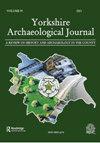Tudor Records of an East Riding Manor: The Manorial Court Rolls of Swanland, 1507 to 1579: An Edition with Full Translation
IF 0.2
0 ARCHAEOLOGY
引用次数: 0
Abstract
the leasing of its estates to lay tenants necessitated a total reorganisation of the abbey’s record keeping. Almost all the estate documents for Fountains, including the manorial records, have been lost, apart from the charters; cartularies, therefore, are of prime importance. In marked contrast to the abbey’s first cartulary compiled in the thirteenth century, in which its holdings appear under the granges in which they were situated, in all subsequent cartularies they are listed in alphabetical order. Five cartularies date from the long fifteenth century, one detailing the rights and privileges granted to the monastery by the papacy and the monarchy, the other four dealing with the abbey’s properties. A sixth may once have existed but has since disappeared. The ambiguously named President Book (i.e. precedent book), a quasi memorandum book closely associated with John Greenwell, which contains among much else genealogical tables of the abbey’s early benefactors and a chronicle of abbots in which the offending Robert Frank has been all but air-brushed out, supplies very detailed indexes and finding aids to these later cartularies. In addition to the in-depth discussions of the cartularies and other Fountains archives in five out of the seven chapters of the main text, the last quarter of the book has been given over to a series of appendices in which the President Book, the later cartularies, a rental volume, a deeds register and a charter of William of Goldsborough have been subjected to very precise codicological description and analysis. While anyone seriously interested in the history of Fountains will welcome new information about the abbey in the long fifteenth century, the questions raised in this study concerning the intentions of the compilers of monastic documents and the connections it makes between the various classes of records will be particularly relevant for scholars embarking upon an edition of a medieval cartulary.都铎王朝东骑术庄园记录:斯旺兰庄园法庭档案,1507年至1579年:完整翻译版
将庄园租给普通租户,需要对修道院的记录保存进行全面重组。除了特许状,喷泉庄园几乎所有的遗产文件,包括庄园记录,都已经丢失;因此,抽签表是最重要的。修道院在十三世纪编制的第一本登记簿上,财产都列在它们所在的田庄下面,与之形成鲜明对比的是,后来所有的登记簿都是按字母顺序列出的。五份cartulra可以追溯到漫长的十五世纪,一份详细描述了教皇和君主授予修道院的权利和特权,另外四份涉及修道院的财产。第六种可能曾经存在过,但后来消失了。命名含糊不清的总统书(即先例书)是一本与约翰·格林威尔密切相关的准备忘录,它包含了修道院早期捐助者的家谱表和修道院院长的编年史,其中冒犯的罗伯特·弗兰克(Robert Frank)几乎被抹去了,它为这些后来的词典提供了非常详细的索引和查找辅助工具。除了在正文的七章中的五章中对cartularies和其他喷泉档案进行深入讨论之外,本书的最后四分之一已经被用于一系列附录,其中总统书,后来的cartularies,租赁卷,契约登记册和戈德斯伯勒威廉的宪章已经受到非常精确的法典描述和分析。虽然任何对喷泉历史有浓厚兴趣的人都会欢迎有关15世纪修道院的新信息,但这项研究中提出的关于修道院文献编纂者意图的问题,以及它在各种记录之间建立的联系,将与学者们着手编纂中世纪词典的版本特别相关。
本文章由计算机程序翻译,如有差异,请以英文原文为准。
求助全文
约1分钟内获得全文
求助全文

 求助内容:
求助内容: 应助结果提醒方式:
应助结果提醒方式:


